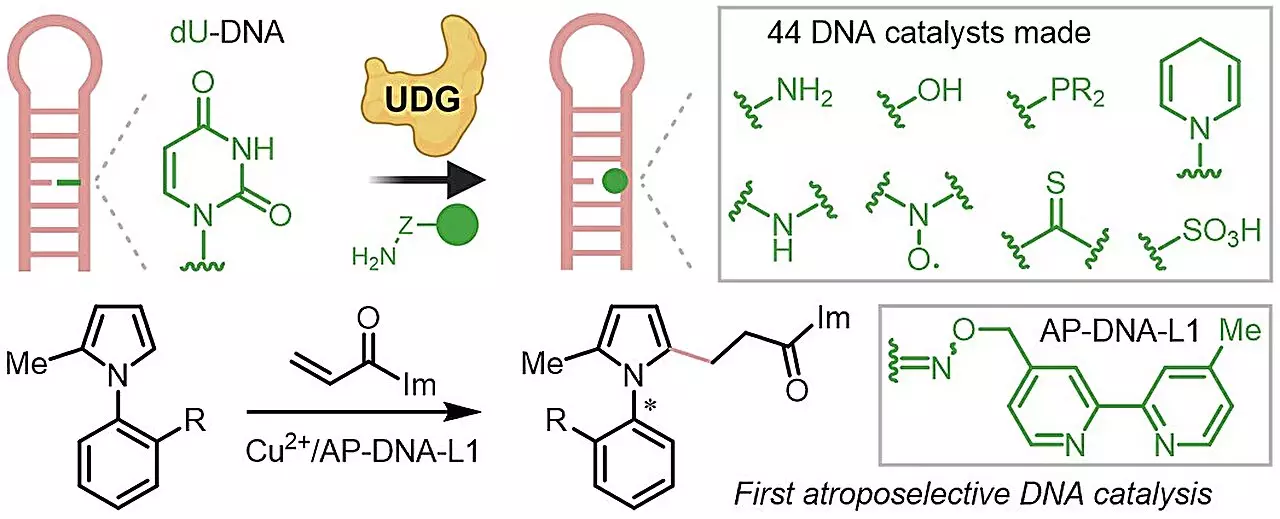Recent developments at the National University of Singapore (NUS) have introduced a groundbreaking approach to asymmetric catalysis through the innovative use of DNA. Led by Assistant Professor Zhu Ru-Yi and his research team, these chemists are merging the principles of DNA repair with biorthogonal chemistry. This pioneering method showcases DNA’s potential as a robust and versatile chiral catalyst, representing a significant leap forward in the field of synthetic chemistry.
Asymmetric catalysis is crucial for the production of chiral molecules, which have applications across pharmaceuticals, agricultural chemicals, and various material science domains. Traditionally, enzyme catalysis has been favored for this purpose, harnessing natural proteins to enhance reaction rates. However, the practical implementation of enzyme-based catalysts is often hindered by their inherent instability and the complex laboratory protocols required for their effective deployment.
In contrast, DNA presents a promising alternative due to its stability and the well-established methods available for its manipulation. Since DNA is a genetically encoded molecule with a unique base-pairing system, researchers can program its sequences with incredible precision, allowing for tailored structural and functional properties.
The NUS research team’s recent study dives deep into the intersection of enzymatic processes and sophisticated chemical transformations. By leveraging DNA repair mechanisms and biorthogonal chemistry, they have created a streamlined pathway for synthesizing diverse chiral DNA catalysts. This method significantly lowers the barriers for entry into DNA catalysis, enabling scientists, even those lacking specialized training, to participate in sophisticated catalytic processes without extensive equipment.
Importantly, biorthogonal reactions maintain functional group integrity, allowing for a wide range of chemical functionalities to be integrated without compromising the catalyst’s effectiveness. These factors combine to present an innovative, user-friendly platform for asymmetric synthesis.
The researchers at NUS successfully constructed a library comprising 44 distinct DNA catalysts, each optimized for enhancing enantioselectivity, substrate versatility, and overall reaction efficiency. These catalysts represented a considerable evolution in DNA-based catalysis, achieving results that surpassed previous findings. Moreover, the team’s demonstration of atroposelective DNA catalysis marks a notable milestone, yielding axially chiral compounds that have historically posed challenges in synthesis via conventional biological methods.
This methodological advancement is not just about immediate applications; it serves as a foundation for future explorations in DNA-catalyzed reactions. The adaptability of these newly developed DNA catalysts highlights their potential for synthesizing a range of complex molecules that are vital for various industrial processes.
The Road Ahead for DNA Catalysis
Looking to the future, the NUS team aims to refine and expand their catalysis techniques with an emphasis on selectivity and sustainability. Their work not only opens new avenues in synthetic organic chemistry but also embodies a shift toward greener technologies in chemical manufacturing. By advancing the accessibility and versatility of DNA catalysis, this research has the potential to transform how chemists approach the synthesis of chiral compounds, leading to more efficient processes that are aligned with environmental considerations. The integration of DNA in catalysis reflects a broader trend in scientific research, demonstrating the power of interdisciplinary approaches in tackling complex chemical challenges.


Leave a Reply